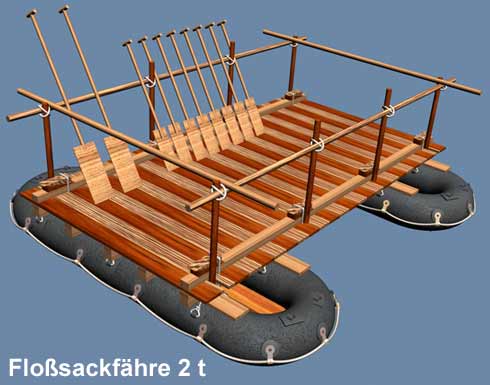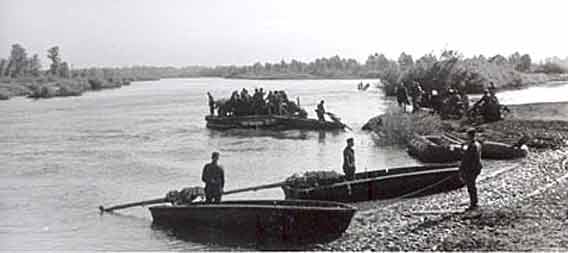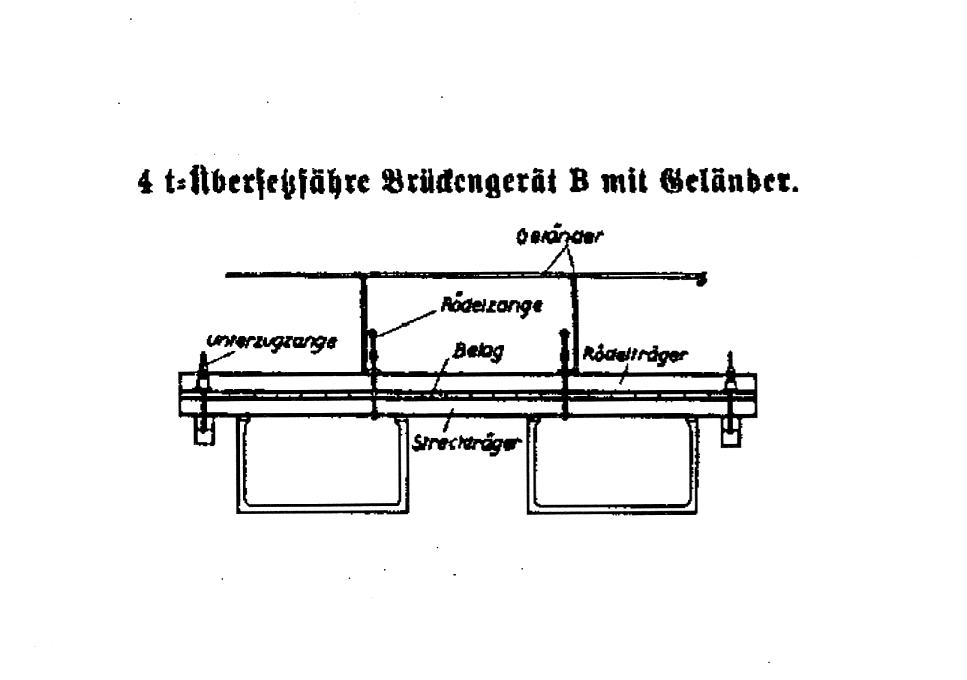


Le Sturmbootmotor 39 ( Saumur Musée du moteur )
English Translation
 |
Pour traverser un cours d eau il faut soit un pont soit des bateaux soit un pont de bateaux
Dans ce photoscope je vous montre un moteur de bateau allemande conserve au Musée des Moteurs de Saumur
Mais avant je vous fais un petit historique des Moyens de franchissement du Génie allemand
Les moyens de franchissement du Génie allemand (1939 1945 )
 |
|
Flosssackfaehre 2 t
|
Ce moyen de franchissement de 2 tonnes de charge utile est constitué de 2 grands bateaux gonflable en caoutchouc
Il est en dotation dans les Divisions d’infanterie de la Wehrmacht
Les bataillons de Génie (Pionierbataillon) étaient équipé de 36 grands bateaux gonflables (GrossFlosssaecke ) En outre, il est possible de réunir 18 ferries 2 tonnes à condition d avoir le bois nécessaire pour fabriquer ce moyen de franchissement
Certaines division d'infanterie ont en dotation dans leur bataillon du génie des pontons de type C (Brueckengeraet C) qui sont 24 grands bateaux gonflables elles éléments en bois et corde ce qui donne la possibilité de construire rapidement des pontons d’une capacité de charge de 2 à 9 tonnes
La taille du ponton etait de 6,25 de long pour 2,66 m. de large . il pouvait supporter des charges allant jusqu’à 2 tonnes Deux cordes solides d’un diamètre 4.5 cm et de 4 m à 4.8 m de long étaient tendues de chaque coté
exemple de chargement
Camion avec section d’assault armés (10 soldats avec fusil, mitrailleuse )
attelage de 2 chevaux
Attelage avec une mitrailleuse et ses munitions,
2 mortiers de 50 mm avec leurs moyen de transports et dotation en munitions,
1 mortier de 81,4 mm. avec leurs moyen de transports et dotation en munitions
1 canon de 75 mm FH16 seul
1 chariot de canon de 75 FH 16
1 Roulante sans cheval,
2 canon anti char de 37 ou47 mm avec attelage
6 motos avec équipage
3 side avec équipage (9 personnes)
1 ou 2 voitures VTT légères avec l'équipage,
1 voiture VTT moyenne avec un équipage,
1 camion pesant jusqu'à 2 tonnes (si la longueur le permet ).
Ce moyen de franchissement est construit par 12 hommes en 35-40 minutes.
L'équipage de cet ensemble etait de 12 personnes.
un commandant du bac (obergefrayter ),
deux hommes pour le pilotage (gefraytery ),
huit rameurs (gefraytery pionir ou des soldats d'infanterie),
un Barreur (gefrayter ).
 |
 |
| Internet | Internet |
Les bateaux étaient en caoutchouc ils mesuraient -5,5 M de long pour 1.86 m de, large
Les boudins avaient 60 cm de diamètre et ils pesaient 149,7 kg.
L’intérieur était divisé en 4 compartiments tous indépendants pour le gonflage
Le fond du bateau était recouvert de latte de bois
Le lot de bord pour ce canot était 2 pompes à pieds , enveloppe de transport du canot 6 avirons et un gouvernail
Le bateau etait gonflé en 15 mm . Il était prevu pour être mis en ouvre par 4 ou 6 rameurs
mais attention 2 bateaux reliés ensembles donnent un poids total de 5.5tonnes A ce poids total il faut retrancher le poids des 2 bateaux 150kgs x2 soit 300kg , le poids de l’équipage soit 12x80 kgs 960 kgs le poids des appareillages divers cordes et bois doit 1450kgs on arrive alors a une charge de 2.710 Tonnes soit près de 50 % de la capacité d’emport Il reste 2.790 tonnes de charge utile et encore faut il retirer une marge de sécurité . Alors lorsque vous fait un diorama soyez vigilants sur la cohérence du chargement de ces pontons pour monter ce pontons il fallait 5 sections de bois de 14 cm d’épaisseur et de 6.25 m de long Ces sections de bois reposaient sur 4 planches de 3.5m de long 25cm de large et 4.5 cm d’épaisseur posées sur les boudins en caoutchouc Elles sont maintenues par des cordes . Un plancher en bois peut être alors fixé fait avec des rondins de 6.5m de long et de 8 cm de diamètre Des gardes fous sont placés à une hauteur de 1.5 m
Ainsi avec ces planches et 312 mètres de cordes sans clou vous avez un ponton de 2tonnes de charge utile.
 |
 |
 |
| Internet | Internet | Internet |
Vous trouverez si dessous les éléments nécessaires pour construire ce ponton
2 bateaux gonflables
4 planches de 4 à 4.80m de long x 25 cm large et 4,5 cm épaisseur,
5 poutres section 14 18 ou 20cm d’une longueur de 6,25 m.;
27 planches de 3,50 m. x 25 cm x 4,5 voir;
2 poutres de section 10/14 cm d’une longueur de 6,25 m
2 poutres de diamètre 8cm longue de 4,50 m
2 poutres de diamètre 8cm longue de 6,50 m ;
16 coins;
312 m. de corde
Delai montage 40 minutes
Pour la manoeuvre 8 hommes sont nécessaires placés par paire à l avant et à l arrière du bateau Le chef de bord lui se trouve sur le ponton au centre La vitesse de déplacement est de 5 km : heure soit 1.5metre par seconde La profondeur d’eau nécessaire ne doit pas être inférieure à 50 cm et il faut aménager un quai de chargement et de déchargement surtout pour le matériel
Ce dessin est tiré du manuel H.Dv.316. Pionierdienst aller Waffen (All.Pi.D.) et illustre le schéma type pour un transbordement
Lorsque la largeur du fleuve excède 100 mètres il est possible de faire passer le ponton d’une rive à l autre sans équipage ou pousseur motorise
En effet via un système de cordage qui sont tirés d’une rive à l autre aidé par le courant du fleuve. Mais cela nécessite un quai de débarquement et d embarquement très solidement construit sur chaque rive
C’est Les Moteurs Hors bord en 1880 à Paris que le 1880, le premier bateau à moteur hors mis au point par Gustave Trouvé fait ses essais pour etablir un premier record officieux pour hors-bord à la vitesse de 10.8km/h pour atteindre actuellement 216 kms/h
Tout au long du XX siècle, les bateaux à moteur hors-bord n'ont cessé de se perfectionner, pour atteindre un niveau de compétitivité internationale et les militaires se sont intéressés à ce type de motorisation .
Les allemands n avaient pas maîtrisés au contraire des américains le systeme de transmission Z
Le Sturmbootmotor 39
 |
| Merci aux Colleurs de Plastiques |
C’est un moteur hors bord pour bacs où bateaux des soldat du génie mis en service en 1939 .C’est un moteur à quatre temps avec quatre cylindres refroidi par eau de type Boxer comme celui de la Volkswagen coccinelle d’une puissance de 30 CV.
Le Sturmbootmotor est avant tout le moteur de la Sturmboot 39 (bac ou bateau du génie mis lui aussi en service en 1939)
On peut l’utiliser des pontons simples où des bacs. Il replacera graduellement les autres hors bords pour pontons.
Caractéristiques
Boxermotor 4 temps avec 4 cylindres refroidi par eau
poids à vide 170 kg (sans carburant et huile de graissage)
Poids équipé 187 kg (avec carburant et huile de graissage)
Longueur 4125 mm
Largeur 843 mm
Hauteur 620 mm
Puissance 30 cv
cylindrée totale 1633 cm/3
Hélice (à trois pales), diamètre 275 mm
Tours de l’hélice 3000 tours/min.
Vitesse (employé avec un Sturmboot) 28 à 30 km par heure
capacité du réservoir du carburant 18 litres
consommation de carburant 10 à 12 litres par heure
capacité du réservoir à l' huile de graissage4 litres
consommation de l' huile de graissage 0,3 litres par heure
Utilisation en continue une heure et demie
Merci a Mickaël pour la traduction de certains termes techniques
Autre Photoscope (Other Walk Around) 1
Voir Aussi See Also leichte Pionier-Sturmboot 39 Batterie Todt
 |
|
 |
 |
| Internet |
.jpg) |
.jpg) |
 |
To cross a course of water must be either a bridge or boat or a bridge of boats
In this walk around I show a german motor boat retains on Saumur Engines Museum
But before I make a little history means crossing the German engineering
Germany Engineering weapons (1935-1945)
 |
| Movable 2-ton ferry from large inflatable boat 2t Flosssackfaehre 2T |
Movable 2-ton ferry carrying capacity of two large inflatable rubber boats was Scheduled perepravochnym means infantry divisions in the Wehrmacht during World War II. Engineering battalion Division (Pionierbataillon) was armed with 36 large inflatable boats (Gross Flosssaecke), The German boat engine
To cross a course of water must be either a bridge or boat or a bridge of boats
In this photosheet I show you a motor boat retains the German Museum of Saumur Engines
But before I make a little history means crossing the German engineering
The means of crossing the German engineering (1939 1945)
Flosssackfaehre 2 t
This means crossing of 2 tons of payload consists of 2 large inflatable rubber boats
It is staffing in the infantry divisions of the Wehrmacht
The battalions of Engineering (Pionierbataillon) were equipped with 36 large inflatable boats (GrossFlosssaecke) furthermore, it is possible to assemble 18 ferries 2 tons of having provided the wood needed to make this means of crossing
Some Infantry Division have staffing in their engineering battalion pontoons type C (Brueckengeraet C), which are 24 large inflatable boats they elements in wood and rope which gives the opportunity to build quickly pontoons of a load capacity 2 to 9 tons
The size of the pontoon was of 6.25 to 2.66 m. long, wide. it could incur charges of up to 2 tons Two solid ropes with a diameter of 4.5 cm and 4 m to 4.8 m in length were strained on each side
example loading
Truck with armed assault section (10 soldiers with rifles, machine guns)
coupling of 2 horses
Driving with a machine gun and ammunition,
2 of 50 mm mortars with their means of transport and provision of ammunition,
1 mortar 81.4 mm. with their means of transport and provision of ammunition
1 barrel 75 mm single FH16
1 trolley cannon 75 FH 16
1 Rolling without horse
2 anti-tank gun 37 mm with coupling ou47
6 bikes with crew
3 side with crew (9 persons)
1 or 2 cars ATV light with the crew,
1 ATV average car with a crew,
1 truck weighing up to 2 tons (if the length permitting).
This means crossing is being built by 12 men in 35-40 minutes.
The crew of the package was 12.
commander of a tank (obergefrayter)
two men to steer (gefraytery)
eight rowers (gefraytery pionir or infantry)
a Helmsman (gefrayter).
 |
 |
| Internet | Internet |
The rubber boats were they measured -5.5 m long and 1.86 m wide
The boots had 60 cm in diameter and weighed 149.7 kg.
The interior was divided into 4 compartments for all independent inflation
The bottom of the boat was covered with wood lath
The lot on board for this canoe was 2 pumps feet, wrapping of transporting 6 canoe oars and a rudder
The boat was inflated to 15 mm. It was expected to be implemented by 4 or 6 rowers
but be careful 2 boats linked together provide a total weight of this 5.5tonnes A total weight we must subtract the weight of 2 boats 150kgs x2 is 300kg, the weight of the crew is 12x80 kgs 960 kgs weight of equipment various strings and wood must 1450kgs one arrives then a load of 2,710 tons or nearly 50% of the payload It remains 2,790 tonnes of payload and yet it must withdraw a safety margin. So when you made a diorama be vigilant about the consistency of loading these pontoons to mount the pontoons must be 5 sections of wood 14 cm thick and 6.25 m long These sections based on 4 wooden planks of 3.5m long 25cm wide and 4.5 cm thick put on rubber boots and maintained by ropes. A wooden floor can then be set out with logs of 6.5m long and 8 cm in diameter Guards madmen are placed at a height of 1.5 m
So with these boards and 312 meters of ropes without nail you have a pontoon 2tonnes payload.
You will find below if the elements necessary to build the pontoon
2 inflatable boats
4 plates 4 to 4.80m long x 25 cm wide and 4.5 cm thick,
5 beams section 14 18 or 20cm with a length of 6.25 m.;
27 planks of 3.50 m. x 25 cm x 4.5 see;
2 beams section 10/14 cm with a length of 6.25 m
2 beams 8cm long diameter of 4.50 m
2 beams 8cm long diameter of 6.50 m;
16 corners;
312 m. Rope
Delay mounting 40 minutes
For the manoeuvre 8 men are required to pair placed by the front and rear of the boat The boat's captain he is on the pontoon at the center speed is 5 km: Time is a second 1.5metre The depth of water needed must not be less than 50 cm and we must build a dock for loading and unloading especially for equipmen
 |
 |
 |
| Internet | Internet | Internet |
This design is taken from the manual H.Dv.316. Pionierdienst go Waffen (All.Pi.D.) and illustrates the typical pattern for a transhipment
When the width of the river exceeds 100 metres it is possible to get the pontoon from one shore to the other without crew or pusher powers
Indeed via a system of rope which are drawn from one bank to another assisted by the current of the river. But it requires a dock landing and boarding very solidly built on each side
That Motors Out board in 1880 in Paris as 1880, the first motor boat off developed by Gustave Found fact tests to establish its first e unofficial record for outboard speed 10.8km / h to achieve currently 216 km / h
Throughout the twentieth century, motor boats outboard have continued to improve, reaching a level of international competitiveness and the military were interested in this type of engine.
N The Germans had not mastered unlike the American system of transmission Z
The Sturmbootmotor 39
 |
| Thank to Colleurs de Plastique Forum |
This is an outboard motor for boats of military engineers put into service in 1939. It is a four-stroke engine with four-cylinder water-cooled Boxer type such as the Volkswagen Beetle with a capacity of 30 CV.
The Sturmbootmotor is primarily driving the Sturmboot 39 ( boat ofr military engineers also put into service in 1939)
We can also for simple pontoons or ferry. It gradually replace other for outboard pontoons.
Technical Data
Boxermotor 4 time with 4-cylinder water-cooled
unlading weight 170 kg (without fuel and lubricating HUIE)
Equipped weight 187 kg (with fuel and lubricating oil)
Length 4125 mm
Width 843 mm
Height 620 mm
Power 30 hp
total 1633 cubic cm / 3
Propeller (three blades), diameter 275 mm ( propeller 3000 rpm ).
Speed (used with a Sturmboot39 ) 28 to 30 km per hour
tank capacity 18 liters of fuel
fuel consumption 10 to 12 liters per hour
reservoir capacity to the oil graissage4 liters
consumption of the lubricating oil 0.3 liters per hour
Using in continuous one and half hours
Thanks to Mickaël for his help for the translation of some technical words